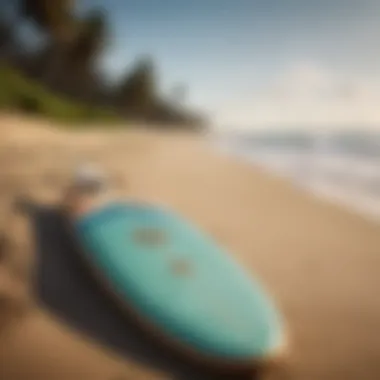Balancing Affordability and Quality in Longboard Surfboards


Intro
When it comes to hitting the waves, choosing a longboard surfboard can be a game changer. But the quest for the right board isn’t just about riding the tide; it often hinges on two crucial factors: affordability and quality. As surf enthusiasts know, the sea can be both forgiving and daunting, and having the right equipment can make all the difference in one’s surfing experience.
In this article, we’ll peel back the layers of longboard surfing gear, especially looking at how to snag a decent board without busting your bank account. Surfboards come in a variety of shapes, sizes, and construction styles, and understanding what you need can help you make an informed decision. This guide aims to provide a comprehensive understanding of longboards, allowing surfers—whether novices or seasoned pros—to find a board that suits their skill level and financial capacity while maintaining excellent performance on the water.
Surfboard Reviews
Types of Surfboards: An Overview
Understanding the different types of surfboards is akin to knowing the ropes before diving in. Longboards, specifically, offer a unique ride that’s generally stable and perfect for catching waves at a leisurely pace. These boards come in several varieties, each designed to cater to different surfing styles and preferences. Here are some popular longboard types:
- Classic Longboards: Typically over 9 feet long, these are great for beginners. They provide stability and are easier to paddle, making them ideal for catching small waves.
- Mini Longboards: Slightly shorter (around 7 to 9 feet), they combine maneuverability and stability. Perfect for surfers who want a bit more agility while still enjoying the longboard vibe.
- Fun Shapes: With their creative designs, these boards offer a hybrid experience. They’re usually shorter but wider, offering unique rides especially in small to medium waves.
- Fish Longboards: With a wider tail and more volume, fish longboards are a blend of funboard characteristics and traditional longboard features. These boards allow for greater speed and maneuverability.
Each type comes with its own construction materials and designs, which can further affect performance. Common materials include foam, epoxy, and fiberglass, impacting how the board performs in various conditions.
Best Surfboards for Beginners and Pros
Finding a board that meets both affordability and quality standards can feel like searching for a needle in a haystack. However, here are some solid choices that cater to both ends of the spectrum:
- Bic Sport 9'4" Perf Longboard: This board is known for its durability and user-friendliness. Perfect for beginners looking to get their feet wet in longboarding.
- California Board Company 8' Longboard: Ideal for those on a budget without compromising too much on quality. This board offers good stability and ease of control.
- Catch Surf Odysea 9' Soft Top: Famous for its softer top, this option provides both safety and style, appealing to the youth and fun-loving crowd, yet it performs well on the waves too.
- Surftech 9'6" Softop Longboard: A versatile choice, providing solid performance with a slightly higher price tag, but comes with exceptional durability and float.
Choosing a longboard suitable for your experience level and unique needs goes a long way in ensuring you get the most out of your time on the water.
Preface to Longboard Surfboards
Understanding longboard surfboards is critical for anyone diving into the surf culture or looking to improve their wave-riding skills. These boards are more than just tools; they symbolize a lifestyle and a unique approach to a beautiful sport. At their core, longboards offer a distinctive riding experience that sets them apart from other surfboard types. While there are many options in the market, the focus in this article is the intricate balance of affordability and quality within longboard surfboards. This is especially pertinent for those who are just starting out, as it can be tough to find gear that doesn't break the bank.
Definition and Characteristics
Longboard surfboards are defined by their length, typically ranging from eight to twelve feet. Longer boards provide greater stability than their shorter counterparts, making them a preferred choice for many surfers, especially beginners. The characteristics of these boards—like the rounded nose, flat bottom, and wide tail—contribute to their usability in various wave conditions. Their buoyancy allows for easy paddling and catching waves, providing greater enjoyment as riders glide smoothly across the surface.
Moreover, longboards can be crafted from different materials such as fiberglass or epoxy, enhancing their durability, which is crucial for newcomers trying to navigate the learning curve. In essence, choosing a longboard means opting for a softer introduction to surfing, one that permits leisurely rides and the opportunity to master skills at a comfortable pace.
The Appeal of Longboarding
The allure of longboarding extends beyond mere functionality; it intertwines with the community, the lifestyle, and the culture surrounding the sport. Longboarding attracts those who appreciate a slower, more graceful style of surfing. The rhythm and flow of riding a longboard allow surfers to connect more intimately with the waves and the environment. This style promotes a sense of calmness that contrasts sharply with the more aggressive runs associated with shortboards.
For many, longboarding isn't just about catching waves; it’s about experiencing the ride itself. Picture yourself cruising down a long stretch of coastline, with the sun warming your back and the ocean breeze tousling your hair. It's about carving turns with elegance, performing smooth transitions, and enjoying the moment rather than just the thrill of competition.
The longboard community has fostered a welcoming atmosphere, embodying camaraderie, shared experiences, and mutual respect for the ocean. Riders often speak of the bonds formed not just through the sport but also under the shared sun and surf, making longboarding more than just a hobby—it's a lifestyle choice that reflects the passion for surfing culture.
In concluding this introductory section, as surfers or outdoor enthusiasts, understanding the definition, characteristics, and overall appeal of longboard surfboards sets the foundation for exploring various aspects related to affordability and quality that will be addressed in subsequent sections.
Understanding Affordable Options
The quest for affordable longboard surfboards often feels like finding a needle in a haystack, especially when the allure of quality craftsmanship beckons. Understanding the landscape of affordable options is crucial for surfers who want to enjoy the waves without sinking their finances. This section delves into various factors such as market dynamics, price variations, and the impact of budget surfboards on performance.
Market Dynamics of Cheaper Longboards
In recent years, the market for cheaper longboards has expanded significantly. As more people take to the water, surf brands have jumped on the bandwagon, producing budget-friendly options alongside premium models. This surge in supply has led to competition, bringing prices down and making it easier for enthusiasts to access multiple choices.
Key Considerations:
- Manufacturing Trends: In a bid to cater to budget-conscious consumers, many brands have shifted their focus to mass production techniques. These can involve the use of less expensive materials or simplified designs that do not compromise on performance for casual users.
- Market Influencers: Online platforms such as Reddit and Facebook have become hubs for discussions on budget boards. Users share experiences, which not only informs potential buyers but also increases competition among manufacturers.
By understanding these market dynamics, surfers can make informed choices, ensuring they strike a balance between cost and capability.
Price Ranges and Budget Considerations
When it comes to longboards, prices can vary wildly. On average, a decent longboard can cost anywhere from $300 to $1,200, depending on its construction and brand reputation. It is important for surfers to know where they fall within this spectrum.
Typical Price Ranges:
- Entry-Level Boards ($300 - $600): These options are excellent for beginners or casual surfers. Generally, they use softer materials and may not be as durable or high-performing as more expensive choices. However, they offer a solid introduction to longboarding.
- Mid-Range Boards ($600 - $900): These boards often strike a balance between quality and cost. Materials are better, and performance generally satisfies more serious surfers who aren't ready to invest in top-shelf gear.
- High-End Boards ($900 and above): Tailored for experienced surfers looking for stellar performance, high-end boards often feature advanced materials and are designed for specific surfing styles.
In making budget considerations, a few factors come into play:
- Frequency of use: If you surf often, investing in a mid or high-end board might save you money long term as they tend to last longer.
- Surf conditions: For different waves or surf styles, specific boards can excel; thus, determining your surfing habits is essential prior to purchase.
- Resale value: Some brands hold their value well; consider this if you think you might want to upgrade in a few years.
In summary, understanding affordable options is essential for surfers who desire to make smart purchasing decisions. This knowledge equips them to navigate through the sea of choices without sacrificing quality for the sake of budget.


Materials and Construction
Understanding the materials and construction techniques used in longboard surfboards provides significant insight into their overall performance, durability, and affordability. The interplay of these factors can greatly influence a surfer’s experience. High-quality materials often translate to better performance in the water, but they can also punch a hole in your wallet. Therefore, knowing what materials are available helps in making informed purchasing decisions that align with both your budget and your needs.
Common Materials Used
Fiberglass
Fiberglass has gained popularity among longboard enthusiasts largely due to its impressive balance of strength and weight. It is primarily made from woven strands of glass, which are coated in a resin to create a flexible yet sturdy surface. What sets fiberglass apart from other materials is its ability to maintain structural integrity while still being lightweight. This characteristic is particularly beneficial for those looking to execute tricks or maneuver through waves without the bulk.
However, it does come with its downsides. Fiberglass boards can be prone to dings and breaks when faced with rough conditions, especially if the board is on the cheaper end of the spectrum. Thus, while a fiberglass board is poplar for performance, the investment must be weighed against potential repair costs.
Epoxy
On the other hand, Epoxy surfboards have grown in traction as a more durable alternative to traditional designs. Unlike fiberglass, epoxy boards use a foam core that’s surrounded by a resin made from epoxy compounds. A standout feature of epoxy boards is their buoyancy, making them easier to float and paddle on.
Many surfers favor epoxy boards for their ability to resist damage from dings and increase longevity. Nevertheless, they can be a bit stiffer, which might not appeal to surfers looking for more flex in their ride. So, while they are durable and lightweight, the sensation of surfing on an epoxy board might feel somewhat different compared to fiberglass.
Soft-top
For novices or those surfing in crowded areas, Soft-top boards present an excellent option. These boards feature a foam deck that is less rigid than fiberglass or epoxy options, making it an ideal choice for someone just starting out. The softer surface is not only safer for beginners but also cushier during falls, reducing the risk of injury.
However, it’s important to note that while soft-tops are fantastic for comfort and safety, they often lack the performance characteristics that experienced surfers seek. They might not perform as well in heavier waves and tend to be heavier than their hard-top counterparts. That said, for someone looking to learn the ropes without breaking the bank, soft-tops can be a fantastic choice.
Impact on Performance and Durability
The materials used in longboard construction do not merely affect the aesthetics; they play a crucial role in performance and longevity.
- Performance: The material influences how well the board can maneuver through different water conditions. For example, fiberglass boards tend to offer a more responsive ride, while soft-tops, though safer, may compromise speed and agility.
- Durability: Consider the longevity of the board in combination with the type of surfing it will endure. For those planning on surfing regularly in rough waters, investing in a durable material like epoxy or fiberglass is generally advisable.
"Choosing the right materials means knowing your surfing style and personal preferences. It’s like selecting the right shoes for hiking – it can make or break your experience."
Types of Longboards
The diverse landscape of longboard surfboards offers various types catered to different surfing styles and conditions. This section sheds light on the importance of understanding these types as it directly influences a surfer’s performance and enjoyment.
Different Designs for Varied Styles
Longboards come in several designs, each with its unique flair and advantages. These varied styles not only affect how a board rides the waves but also what kind of experience a surfer can expect.
Classic
The Classic longboard is often seen as the bread and butter of longboarding. Its elongated shape typically ranges from 9 to 12 feet, designed for stability and smooth rides. One of the key characteristics of the Classic is its traditional nose and tail shape. This board is a popular choice among novice surfers who are just dipping their toes into the sea. The length provides extra stability, making it less likely to tip over, essential for someone still learning the ropes.
Unique Feature: The Classic longboard typically comes with a single fin setup, which fosters smooth turns and excellent glide.
Advantages: High stability, ease of paddling, and better balance, especially in small to medium waves.
Disadvantages: The larger size can be cumbersome for transportation and may not perform exceedingly well in aggressive wave conditions.
Fish
The Fish longboard, with its shorter and wider dimensions, brings a different flavor to your surfing experience. This design offers more maneuverability, making it a hit among surfers looking for a thrilling ride. Its key characteristic is the swallowtail shape, allowing for quicker turns and agile movements.
Unique Feature: The Fish often features a twin fin setup, which contributes to its speed and fluidity.
Advantages: Great for quick turns and performing tricks in smaller, mushier waves.
Disadvantages: The surfboards might lack the same stability as a Classic, making it a less ideal choice for beginners or in rough conditions.
Minimalist
The Minimalist is all about simplicity and functionality. This kind of longboard usually ranges from 7 to 9 feet, combining the advantages of both shortboards and longboards. It features a flatter rocker and wider outline, which allows for a lot of versatility.
Unique Feature: The Minimalist design is perfect for surfers who want to paddle easily and still catch waves efficiently.
Advantages: It suits various wave conditions and is easier to handle than traditional longboards, making it a good transitional board for learners.
Disadvantages: While it offers versatility, it may not excel in any particular area compared to more specialized longboards.
Choosing the Right Shape


When selecting a longboard, it’s crucial to consider the shape and its implications on your surfing style. The right shape impacts how well you can maneuver, catch waves, and maintain balance. Each type holds its essence, and a surfer must contemplate their preferences, skill level, and the surf conditions they intend to encounter.
Buying Tips for Budget Surfers
When it comes to selecting a longboard surfboard on a budget, it’s imperative to tread carefully. Buying tips for budget surfers embody not just the financial aspect but also an avenue to enhance your surfing experience without breaking the bank. The right knowledge can steer you toward finding a board that balances affordability with quality, ensuring that every wave is caught, every ride is smooth, and every dollar is well spent.
Many buyers often start with a basic question: where can they score a good longboard without getting conned into spending too much? That’s where understanding key buying avenues becomes essential. Making informed decisions not only saves money but also aids in avoiding regrets down the line.
Where to Buy Affordable Longboards
Online Retailers
When diving into the realm of purchasing longboards, online retailers stand out as a remarkable option. The convenience of shopping from home, combined with the plethora of choices available, makes online platforms a go-to for many surfers. Popular websites often showcase various models that cater to different styles and skill levels, giving you the power to compare prices effortlessly.
One distinct advantage of online retailers is the transparency in pricing; you can spot sales and discounts quickly, which is always a win for budget-conscious surfers. However, caution is warranted—it's possible to encounter misleading product images or inflated prices lurking within endless listings.
Advantages:
- Wide selection of models
- Ease of price comparison
- Access to customer reviews to gauge quality
Disadvantages:
- Possible issues with shipping or delivery delays
- Lack of personal inspection before purchase
Local Shops
Then we have local shops, which often feel like a home away from home for surfers. The charm of being able to physically handle boards and seek advice from knowledgeable staff cannot be overstated. More often than not, local surf shops feature a selection tailored to their community, providing options that might not be readily available online.
Engaging with local experts can provide insights into the best surfboards that align with your lifestyle—something a website might not quite deliver. Also, buying locally often allows you to support small businesses, effectively strengthening the surf community.
Advantages:
- Hands-on evaluation of product
- Direct interaction with staff for personalized recommendations
- Supporting local economy
Disadvantages:
- Limited inventory compared to online
- Potentially higher prices due to overhead costs
Second-hand Markets
Next up are second-hand markets, which can resonate especially well with budget surfers. The thrill of rummaging through offerings at a local garage sale, flea market, or classified ads can lead to some unexpected finds. Many seasoned surfers part ways with their boards that may still have plenty of life left in them, making these an excellent opportunity for novices and experienced surfers alike.
Not only can you find quality boards at a fraction of their original price, but it also allows you to mix nostalgia with surfing culture. That said, due diligence is crucial; inspect the board closely for wear and tear. It is wise to remember that some boards may require repairs or modifications, which can add extra costs if you aren't careful.
Advantages:
- Significant cost savings
- Unique boards with character
- Eco-friendly option to reuse
Disadvantages:
- Risk of purchase if condition is not evaluated properly
- Limited return options if you’re not satisfied
Evaluating Quality vs. Price
Now comes the vital step of evaluating quality versus price. It’s easy to be lured by percentages off or enticing sales, but understanding the craftsmanship behind the board is essential. High-quality materials will usually mean better performance on the waves. If it sounds too good to be true, it just might be.
To summarize the situation, while price plays a significant role in decision-making, one must not forget the value of quality. Comparing boards with similar dimensions and features can help ensure that what you’re paying is fair. For a surfer, striking this balance could be what determines an enjoyable surfing experience or a frustrating one.
Maintenance of Longboard Surfboards
Keeping longboard surfboards in top notch condition isn’t just about aesthetics; it plays a crucial role in prolonging their lifespan and enhancing performance in the water. Maintaining a board can feel like a chore for some, but it’s vital for every surfer, whether you’re shredding waves or just cruising. Proper care can make the difference between a board that bends like a bow under pressure or one that performs like a finely-tuned instrument.
The benefits of regular maintenance are numerous. First, it helps ensure safety by reducing the chances of board failure during a session. A well-maintained longboard responds better in the water, offering a more enjoyable experience. Additionally, taking good care of your board can save you $$ in repairs and replacements down the line.
Care Techniques to Enhance Longevity
To get the most out of your longboard, consider implementing a few care techniques that are easy to follow:
- Rinse After Use: Once you step out of the water, rinse the board thoroughly with fresh water. Saltwater can be corrosive and lead to damage over time.
- Store Properly: Avoid leaving your board in direct sunlight for long periods, as it can cause the color to fade and even weaken the material. Instead, store it in a shaded area or indoors, flat or upright, and not leaning against a hard surface.
- Regular Waxing: A waxed board enhances traction and stability. Depending on how often you surf, re-waxing may be necessary. Check for wax wear and replenish it as required.
- Inspect Regularly: Regularly check for cracks, dings, or other signs of wear. If you catch an issue early, it's easier to fix than to deal with a larger problem later on.
Common Repairs and Solutions


Even with the best care, sometimes repairs are inevitable. Knowing how to handle common issues can save you time and money:
- Dings and Dents: If you find a ding, don’t panic. Small dings can usually be repaired with a simple epoxy resin kit, which you can find at most surf shops. Follow the instructions carefully and allow ample drying time.
- Fins Damage: If a fin is broken, it can significantly affect your board's performance. Most fins are removable, and replacing them is usually straightforward; just find the right fit for your board model.
- Leash Attachment Issues: If the leash plug has become loose or frayed, it’s critical to address this. A simple repair can involve re-gluing the plug with a strong epoxy or replacing the leash altogether.
Remember: Regular maintenance not only prolongs the life of your longboard but also contributes to an improved surfing experience. Treat your board well, and it will treat you well in return.
By adopting these practices, you can enjoy a more seamless surf experience, knowing that your longboard is well-cared-for and ready to hit the waves whenever you are.
Impact of Budget Longboards on Performance
When navigating the waves, having the right gear beneath your feet is essential. In the realm of longboards, the pricing can vary significantly, leading to questions about what you’re really getting for your money. The truth is, budget longboards play a pivotal role in the surfing community, especially for those who are just starting out or are looking to dip their toes into the sport without emptying their wallets.
Different Surf Conditions and Requirements
Each surf condition demands a distinct approach, and this is where budget longboards can somewhat shine, despite common assumptions.
- Small Waves: In mellow conditions, like those gentle summer swells, a budget longboard can perform just fine. These boards offer plenty of stability, making them accessible to beginners. For someone just getting to grips with their balance, a budget board can give the feeling of gliding without the fear of being wiped out in bigger surf.
- Choppy Waters: Here lies a challenge. Cheaper boards are often heavier and might not handle choppy conditions as adeptly as pricier models. However, they can still allow a surfer to practice turning and paddling techniques. A solid choice for honing skills, they're not without their use even in less-than-ideal conditions.
- Performance Waves: When the waves start packing a punch, the limitations of budget longboards can become apparent. Those eager to ride faster waves may feel the difference. High-end boards are typically lighter, allowing for quicker turns and faster catch-up rates. Still, with a bit of creativity, budget longboards can be molded into a tool for learning how to cope in increasing complexities of the ocean.
It’s crucial for surfers to understand their individual needs and how different setups can be optimal for particular surf situations.
User Experiences and Reviews
The perceptions surrounding budget longboards are shaped substantially by user experiences. Reading reviews can provide invaluable insights. Many first-time surfers share stories of how their budget longboard allowed them to link their first rides or how they felt a sense of pride in catching a wave on a less-than-fancy setup. As someone might phrase it, riding any wave is better than just standing on the shore watching.
Feedback often emphasizes the following points:
- Value for Money: Users frequently highlight the affordability aspect, noting that even if these boards aren’t the lightest or fastest, they serve their purpose for beginners and casual surfers.
- Durability vs. Performance: While budget boards may not last as long as high-quality options, numerous users mentioned that they hold up well for the initial learning stage. There’s a sense of appreciation for the temporary aspect; surfers understand the need for eventual upgrades as their skills grow.
- Emotional Connection: There’s something about riding one’s first board that creates lasting memories. Many reviews reflect this sentiment, showing that even budget boards can have a charm and sense of pride behind them. It points to the idea that, for those beginning their journey, your first longboard is often a memorable companion.
"Having the perfect board isn’t everything; it’s about the adventure you carve into the waves."
Ultimately, the takeaway is clear: while budget longboards may not always compare to their high-end counterparts, they offer essential pathways for novice surfers, enriching their experiences and building a solid foundation for future progress.
Environmental Considerations
The connection between surfing and environmental consciousness is becoming increasingly prominent, especially in the context of longboard surfboards. As more people dive into the waves, the impact on coastal ecosystems and marine life is becoming hard to ignore. Understanding environmental considerations is vital not just for the wellbeing of the oceans, but also for the longevity of the surfing community itself. This section delves into sustainable practices within longboard production and emphasizes the role of surfers in conservation efforts.
Sustainable Practices in Longboard Production
The production of longboard surfboards can leave a considerable footprint. Thankfully, many manufacturers are shifting their focus toward sustainability. Sustainable practices are emerging as a keytrend, aiming to minimize waste and environmental impact. Here are some notable methods:
- Eco-friendly materials: Some brands now use sustainably sourced woods and recycled plastics, reducing reliance on virgin raw materials.
- Low-impact manufacturing: Techniques that reduce energy consumption and harmful emissions are being adopted. For instance, utilizing water-based glues and paints reduces toxic output.
- Longevity and Reusability: High-quality longboards, crafted with care, not only enhance the surfing experience but also minimize the need for replacements, which is beneficial for our planet.
By prioritizing sustainable practices, the industry not only caters to environmentally conscious consumers, but also helps preserve the natural beauty of surfing locales for future generations.
The Role of Surfers in Conservation
Surfers are not just riders of the waves; they can also be seen as custodians of the ocean. The surfing community possesses a unique bond with nature, experiencing firsthand its magnificence and fragility. As such, surfers are poised to play an essential role in conservation efforts. Here are some impactful ways surfers can contribute:
- Advocating for clean beaches: Collaborating with local organizations to clean up coastlines helps minimize plastic waste that can harm marine life.
- Participating in ocean preservation initiatives: Engaging in campaigns to protect marine environments showcases the innate responsibility surfers have toward their playground.
- Choosing eco-friendly brands: Opting for longboards produced through sustainable practices reflects a surfer's commitment to the health of the oceans.
"Surfing isn’t just a sport; it’s a movement where the waves meet the mission to protect our blue planet."
In summary, understanding environmental considerations in longboarding lays the foundation for a more sustainable surfing culture. By embracing eco-friendly practices and actively participating in conservation, surfers can ensure that the passion for riding waves endures, side by side with the preservation of the stunning ecosystems they cherish.
Culmination
The conclusion represents a crucial juncture in this article, wrapping up our exploration of the affordability and quality of longboard surfboards. By synthesizing the various elements discussed, it showcases why understanding the delicate balance between cost and performance is paramount for anyone looking to purchase a longboard without breaking the bank.
First, it’s essential we recognize the market’s diversity in longboard options. For surfers on a budget, knowing where to find affordable yet quality boards can lead to enhanced time spent on the waves while keeping the wallet happy. This conversation highlights the necessity of highlighted materials and construction techniques that can offer both durability and comfort, crucial for a satisfactory surfing experience.
Moreover, the environmental considerations we've touched upon serve as an urgent reminder. As you search for budget-friendly options, it is equally vital to think about the ecological footprint of your choice. Are the materials sustainable? Are the brands committed to conservation? Such questions should guide the decision-making process to ensure the sport's future remains viable.
For many, a budget longboard may bring varying perceptions. It is imperative to find how quality sometimes comes at a lower cost without compromising safety or performance. Gathering insights from fellow surfers or reviews can steer one toward sound purchases. This collective knowledge leads to satisfying experiences on the water, ultimately enhancing the joy of longboarding.
"Affordable does not mean compromising; it means knowing what you truly need for a fulfilling surf experience.”
Summary of Key Insights
Bringing together the discussed points, a few key insights emerge:
- The balance between affordability and quality drives the purchasing decisions of aspiring longboarders.
- Diverse market options allow surfers to choose effectively based on personal needs, local conditions, and individual preferences.
- Understanding materials and their impact on performance is crucial to making informed purchases.
- Budget longboards can still provide an exceptional surfing experience if chosen wisely.
- Sustainable practices in producing longboards can positively affect the environment while meeting budget constraints.
Final Thoughts on Affordable Longboarding
As you embark on this journey, consider all angles: material quality, surf conditions, and even the influence of sustainability on your choice. In the end, finding the right longboard resides in understanding one’s needs as a surfer, coupled with the essential knowledge of the market landscape.
Take your time, do your research, and enjoy the process of becoming the proud owner of a longboard that resonates with your surfing style and budget constraints. The ocean is waiting, and you’re one purchase away from riding that perfect wave!















